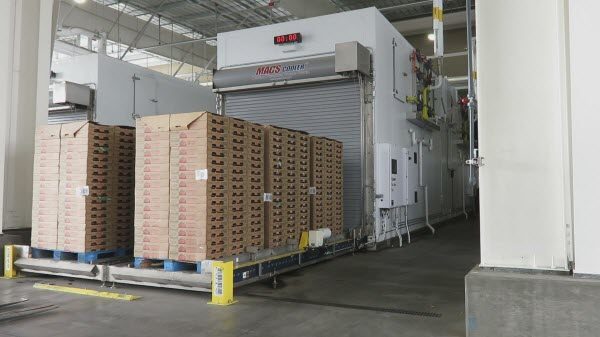MACS Cooler—with the help of Hawkins Engineering, Quantum Automation and AutomationDirect—designed a more efficient precooling system for produce. Not only do these forced-air portable precooling systems reduce labor costs by 60%, they also help assure fresh strawberries quickly make it to market.
All fruits and vegetables are perishable, but strawberries more than most as they must be harvested, cooled and sold within two days before they get soft and squishy.

Strawberries are a major cash crop in California, and they need to make it to market in a timely manner. The California Department of Food and Agriculture, says the state produces over 2.3 billion pounds per year worth $2.6 billion, making it the state’s fifth largest fruit crop.
There are many ways to precool produce, but this case study was focused on the Modular Automated Cooling System (MACS) Cooler built by MACS Cooler. These coolers help minimize floor space and maximize productivity. They were designed at Hawkins Engineering, with the goal of making the fastest automated, forced-air, portable-precooling system available. But first, a quick look at precooling.
Precooling Processes
Before produce is placed in cold storage or shipped to marked, it is usually precooled using one of five methods:
- room cooling
- hydro-cooling
- ice cooling
- vacuum cooling
- forced-air cooling
These processes rapidly cool fresh fruit and vegetables, but have their pros and cons. Room cooling can be slow. Water cooling, while fast, can spread pathogens left by critters in the field. Ice cooling adds weight to the case of produce, and vacuum cooling can dry it. All of these methods have a niche, but forced-air cooling works well for the largest variety of fruits and vegetables.
Traditional forced-air cooling uses tarped cooling tunnels to precool palletized produce. Tarps are placed over two rows of produce pallets in a cold room, and a fan blows air into the tunnel between the two rows and through the boxed produce. This creates a differential pressure across the pallets to draw cold air through them.
The tarped method of forced-air cooling is not very efficient for many reasons. The pallets take significant handling labor, and then the handling labor must be repeated to reverse air flow through the pallets by rearranging the pallets in reverse order.
The MACS Cooler
The MACS Cooler automates the produce precooling process. A standard cooler has two, 24-foot-long insulated cooling modules. One module includes an infeed roller conveyor and two cooling zones. The other module, the outfeed, is the same except the roller conveyor handles the cooled outfeed pallets. To save space in cold storage, most of the system, except the outfeed conveyor, can be installed outside the building.

A key feature of the MAC Cooler is its portability. Place it on a truck and trailer and it can be quickly moved to a new location such as the Oxnard or Salinas growing regions in California, which have two distinct and different growing seasons. One MACS Cooler customer has over 100 precooling sites, and moves the coolers to handle each season’s peak harvest.
The flow-through design of the cooling system is a big labor saver because the pallets are handled less. Fork truck drivers, outside the cool storage facility, load pallets on the infeed conveyors of the MACS Cooler, two at a time. The conveyor automatically moves the pallets and makes room for the next two.
Once three pairs of pallets are on the infeed, the system automatically moves them through the cooling process. The cooled pallets are removed at the outfeed, inside the facility, significantly reducing traffic entering and exiting the cold storage building. The space savings are sufficient to expand production without increasing the size of a refrigerated building.
AutomationDirect is Cool in Agriculture
The original MACS Cooler was designed and installed in 2004. About 85% of the control and integration hardware used is manufactured by AutomationDirect and was purchased from their value-added reseller Quantum Automation. AutomationDirect hardware was selected due to its low cost and ease-of-use. Quantum Automation was chosen for their superior sales and support.

The original design used an AutomationDirect DL205 PLC platform. This provided adequate performance and flexibility, but after well over a decade of design changes and feature additions, a processor upgrade was required. A Do-more Series PLC was selected for this upgrade. It has expanded capabilities and works well with the existing system’s DL205 architecture.
The existing PLC program was converted to the Do-more platform, and the new program ran much faster. Hawkins Engineering re-wrote the program to use indirect addressing and looping. This allowed them to reduce the number of programming rungs by replacing them with short code statements, making the program simpler to read and use.
MACS Cooler customers commented favorably on the substantial improvement in HMI response times provided by AutomationDirect’s C-more EA9 Series HMI Touch Panels upgrade paired with the Do-more PLC.
Another upgrade improving the design was the AutomationDirect ViewMarq industrial LED message display. Originally used as a count-down timer until the next pallet load, additional status information was added. A variety of information is now provided to keep the fork truck drivers and operators productive by allowing them to ascertain system status, even from a distance.
Fresh from D’Arrigo Bros.
The MACS Cooler with the upgraded AutomationDirect hardware including PLCs, HMIs, ViewMarq displays, relays, power supplies, motor starters, contactors, sensors, circuit breakers, DIN rail and terminal blocks, is being used at the D’Arrigo Bros. Company of California (Andy Boy label), a fresh produce grower and distributor.
D’Arrigo wanted to increase production and purchased two MACS Coolers instead of using 12 new tarp tunnels. The coolers worked so well they ordered three new coolers, added some storage space, and can now cool and ship 1.2million pounds of strawberries per day.
For the complete story and additional information, check out this Case study: Make strawberries cool again in the February 2017 issue of Control Design, authored by Orion Williams, Controls Engineer at Hawkins Engineering/MACS Coolers in Moss Landing, CA.
For more information about programmable control, click here.


